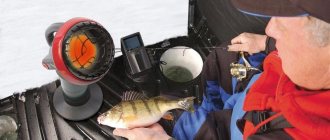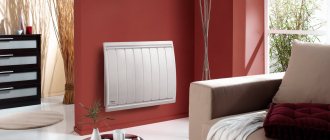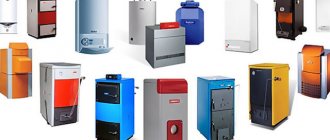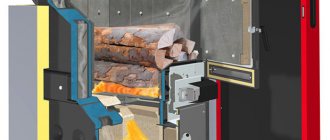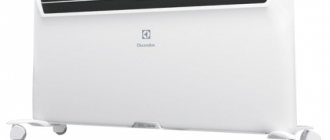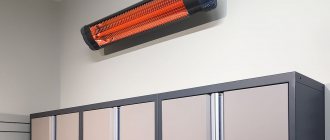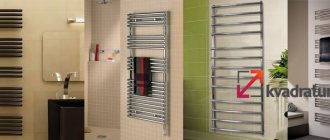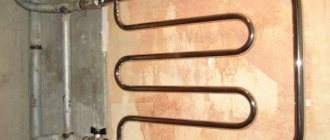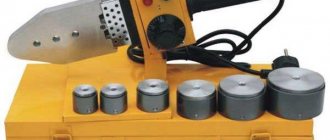How to choose an economical convector for a summer residence, criteria
When choosing a heating electric convector, first of all, the following are evaluated:
Electrical power
The power of the convector is selected depending on the intended area of use. If the equipment is used as the main heating system, the capacity of the installation is calculated based on the ratio of 1 kW per 10 m2 of heated area. To the calculated value, add 15 - 20% for possible heat losses.
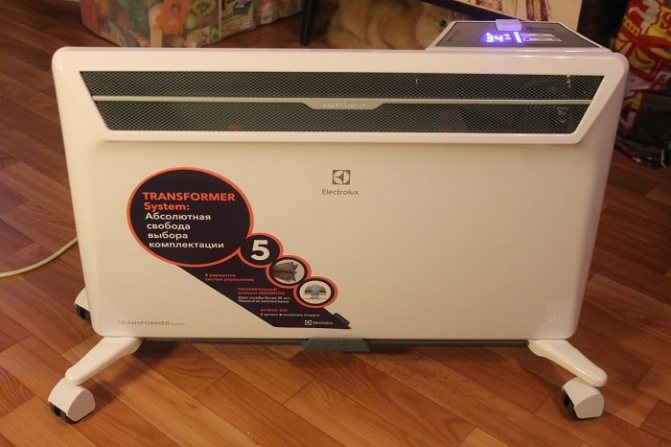
If the device is used as a backup system, the convector power can be significantly lower. The exact value depends on the characteristics of the main heating circuit, the quality of the building's thermal insulation and the outside temperature. As a rule, the power of such convectors ranges from 150 to 500 W.
Thermostat type
Both mechanical and electronic thermostats are used in the design of modern electric convectors. Devices with mechanical adjustment are simple and reliable, but the functionality of such convectors is minimal.
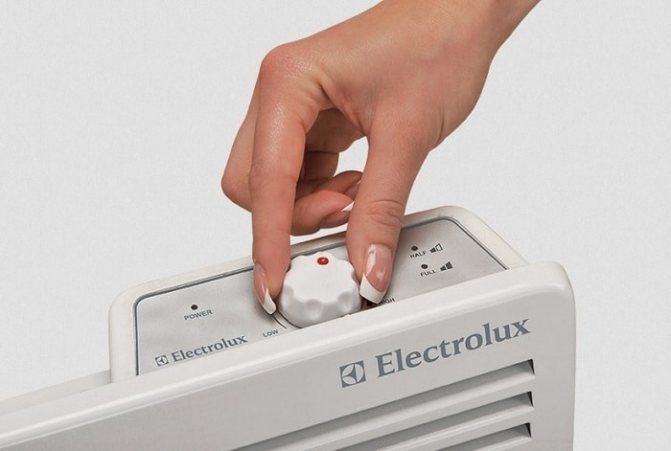

The use of electronic control units ensures precise adherence to the set temperature regime, the possibility of remote and software control, and also allows you to connect additional functional modules.
The use of electronic heating convectors is advisable as the main heating system. For a redundant system, it is more profitable to purchase an inexpensive convector with a bimetallic thermostat.
Heating element type
Electric convectors can have heating elements of both open and closed type. When using an open-type heating element, there is a high probability of burning out oxygen, and in addition, corrosive destruction of the wire spiral is possible under the influence of natural air humidity.
In heating elements of a closed type, the filament is placed in a sealed tube with special aluminum fins designed to increase the efficiency of heat transfer. The use of such heating elements completely eliminates oxygen combustion and corrosion. Despite the higher cost, it is the closed heating elements that are most widely used.
Additional functions
As a rule, additional functions are available for convectors with an electronic control system, they are extremely rare in "mechanical" convectors. The most requested additional features include:
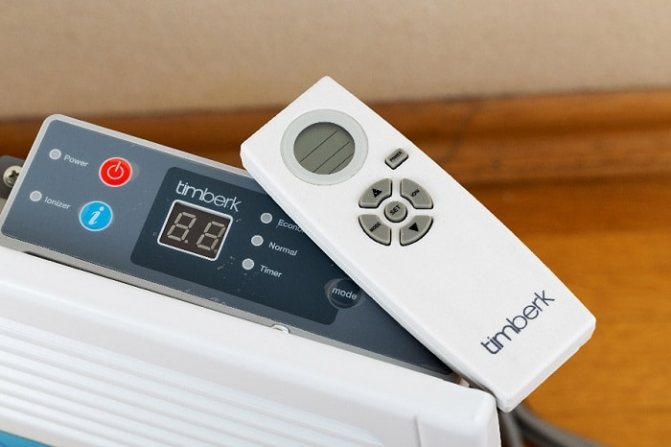

- Anti-freeze mode. When this function is enabled, the unit automatically maintains the room temperature at +5 C, preventing the building from completely freezing in the absence of the owners;
- Work in the programmed mode. The option allows you to automatically change the temperature mode in order to save energy. For example, in the absence of the owners, the convector can operate in the minimum heating mode, and at a certain time, an hour or two before they return, the device switches to the optimal temperature mode.
- The remote control makes operating the device comfortable.
- Switching the convector on and off using a timer allows you to significantly reduce energy consumption.
Device security
To ensure safe operation, the convector must have a number of basic protective functions:
- Reliable protection against moisture ingress;
- Turning off the heating element in case of overturning will avoid a fire;
- Turning off the heating element in case of overheating of the device;
- Protection against freezing, which consists in maintaining the temperature within +5 - 7 C in autonomous mode in the absence of owners.
In addition, if the convector is installed in a children's room, the presence of sharp edges and corners that could injure the child are unacceptable.
Tips for choosing a convector
When choosing a convector heater, take into account its following characteristics:
- Power consumption;
- Heating element type;
- Instrument dimensions;
- Operational safety;
- Additional features;
- Cost;
- Manufacturer;
- Indicators when viewed.
1. So, power. It is selected based on how large the room is to be heated. For example, if it is supposed to use the device in addition to heating during the period when they are not yet heated or are no longer heated, then we calculate the power as follows: for each cubic meter of room volume, 25 watts of power are needed. But if there is no heating in the house at all, then you will have to count on the basis of 40 watts per cubic meter.
Let us give an example: if the area of the room is 19 square meters, the ceilings are 2.7 tenths of a meter, then the power of the heater in the off-season is calculated by multiplying these two values by 25. We get 1285.5 watts. Rounding up, and looking for a heater with a capacity of one and a half kilowatts.
2. Type of heating element. As for the heating element, if you have a choice, take a heater with a cast monolithic heater - it will last longer and work more efficiently.
3. Dimensions of the device. When examining the device, pay attention to its dimensions, especially its height. After all, it depends on it at what speed the air will move. So, for example, low convectors with a height of only 60 centimeters are able to provide a very fast movement of air masses and, accordingly, heat a room faster. It is also important how heavy the device is - after all, you may have to move it from place to place during use.
4. Operational safety. The heater should be as safe as possible. As a matter of fact, convectors are the safest devices for heating. After all, their body is heated only up to 60 degrees, no more, and therefore will not leave burns. Parents of young children prefer models in which the body is devoid of corners and has smooth contours. There is no need for grounding for convectors, and they withstand voltage drops with honor.
5. Additional features. Of the additional features that a good convector has, the following can be noted:
- The temperature regulator is a very handy thing. If it's warm outside, you can screw it up a little, and in case of severe frost, set it to the maximum.
- The thermostat will keep the room at the temperature that is most comfortable for you.
- The timer will make it possible to turn on the heater for a certain time, after which the shutdown device will work. It's a good idea to use this opportunity in the evening, before going to bed.
- A built-in ionizer absorbs dust by saturating the air with negative ions. It is very good for health. In a room with such a microclimate, you sleep better and work more productively.
- The remote control and the on-timer will allow you not to crawl out from under a warm blanket in the morning to warm up the room.
- Roll-over protection is a very important function, especially when there are playful animals or fidgety children in the house.
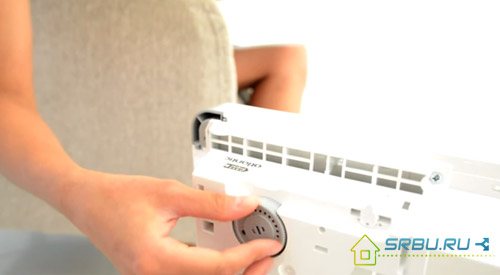

Mechanical control system.


Convector with electronic control system
6. When choosing a heater manufacturer, keep in mind that a good thing cannot be cheap. After all, we all want the heater to be efficient and safe, to work for a long time and have a normal warranty service. Therefore, when choosing a device, turn your gaze towards well-known brands, the guarantee of which is not just empty words.They are really responsible for the quality of their products, which they have been producing for a long time and successfully selling them on the world market.
7. Visual inspection. While examining the convector offered by the seller in the store, take a good look at it for any scratches or dents. Paint drips, body distortions, notches and sharp edges are unacceptable. Screws and bolts must not protrude from the housing. If something you didn’t like or seemed suspicious, it’s better not to take such a heater. After all, this indicates either poor assembly or careless transportation.
Remember the following three rules: 1. Each convector-type heater will dry the air in the room. There is simply no other given, according to the principle of work. The most that can help: a container of water for evaporation. 2. Since air is constantly moving in the process of convection, dust will move with it. Over time, it will accumulate between the plates. If a deceitful seller tells that "only this model" of the convector does not accumulate dust, do not listen to these fables and call another consultant. 3. Any electric heater has an efficiency close to 100 percent. Therefore, do not believe that only this model, stubbornly imposed by the seller, can give such an efficiency.
Convectors rating
Based on the models considered, we will make a rating of convectors in terms of reliability, quality and cost.
In terms of reliability, the Neurot convectors are the leaders. Next come the models of the manufacturers Atlantik, Electrolux and Ballu.
The best wall convectors are Neurot and Timberk. Timberk is again the leader among floor heating manufacturers. Good models are also produced by Electrolux and Ballu.
But among the inexpensive brands, Atlantic convectors can be called. Cheap heating appliances are also produced by the Delonghi company. In general, the reviews about the models of this manufacturer are good. Therefore, if you want to buy a floor convector, the price for which is low, you can safely buy Delonghi products.
It is difficult to give an unequivocal answer which of the described convector models is worth purchasing.
It all depends on the operating conditions, your preferences regarding design, power and other technical parameters, as well as your financial situation. Of course, if the material condition allows, then it is better to purchase models from European manufacturers. In this case, you are guaranteed to get a quality device. If the budget is limited, then you can stop at cheaper Chinese brands.
The presence of a thermostat in the convector
Thermostat device in the convector.
In modern electrical devices, both electromechanical and electronic thermostats (which have an air temperature sensor) are used. All convectors, regardless of the type of thermostat, are equipped with overheating protection.
Such devices with a mechanical thermostat have the following features:
- affordable price;
- accuracy in measuring air temperature (+/- 0.5-1 ° С);
- when the heating is turned off and on, a characteristic click is heard;
- high reliability during operation in conditions of unstable supply voltage (summer cottage, village, and so on).
In electronic thermostats, a microcontroller thermostat is installed. Its temperature sensors regularly measure the temperature of the cold incoming air and send a signal to the control element, which is able to maintain a given mode with an accuracy of +/- 0.1-0.3 ° C.
Features of similar devices with electronic thermostats:
- higher price;
- completely silent work;
- good temperature measurement accuracy.
Due to the higher accuracy of temperature measurement, the use of convectors with an electronic regulator can provide energy savings of 3-5% compared to electromechanical designs. Models that have an electronic thermostat most often support several operating modes: economical, comfort, anti-freezing (the temperature is regularly maintained at + 5-6 ° C) and automatic.
Monolithic heating elements
In monolithic heating elements, a nichrome filament with a dielectric filler is located in a solid aluminum casing with developed fins. When heated and cooled, all parts of the monoblock equally expand and contract, which eliminates friction and the appearance of microcracks. They are quiet in operation and very durable. The monolithic design made it possible to minimize intermediate heat losses and further reduce the temperature on the surface of the ribs in comparison with heating elements. Usually, devices with such heaters have an IP24 degree of protection.
Which convector is better to choose
- Learn more about the housings of such a battery
- Heating element for convectors
- The presence of a thermostat in the convector
- Calculation of the power of such a heating device
How to choose a convector for a summer residence? Today the Russian convector market is incredibly large: both European and Asian manufacturers are represented there. With such a variety, a problem arises related to which convector is better to choose for a summer residence. The main criteria for choosing this device are: safety, economy, long service life, as well as its cost. All these parameters (with the exception of cost) are determined by the design features of the convectors.
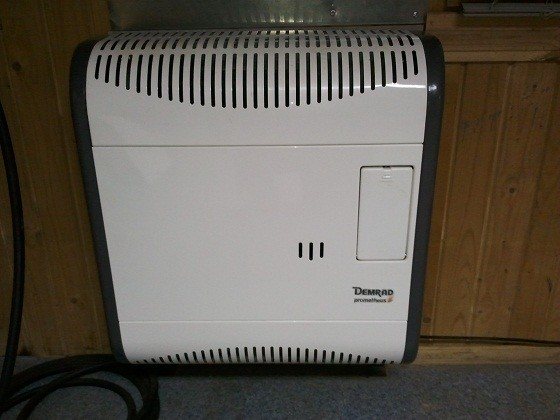

The main parameters when choosing a convector: safety, environmental friendliness, good operation, low cost.
Electric or gas convector? It is necessary to figure out what convectors exist today and whether it makes sense to say that the best are electric, and not any others. A similar device can work on the following types of substances:
- with water;
- using electrical energy;
- using natural gas.
Due to the cost of natural gas, some consumers believe that the best gas convectors can be purchased in Russia. However, with this type of equipment, not everything is as simple as it seems. Finding such batteries is quite difficult when electrical units are sold everywhere.
Which convector is better to choose for a summer residence: wall-mounted or floor-standing?
Stages of installing a wall-mounted convector.
First of all, you need to decide how you plan to use the electric convector. Most often, electric convectors are installed permanently on the wall, under windows, or on a special bracket that comes with the kit. If you want to get a mobile heater that can be moved around the room, you will need to additionally purchase a set of legs (in most cases, it is sold separately for wall-mounted convectors) or buy a convector that is designed specifically for floor installation. Such batteries, which are originally intended for floor installation, are equipped with roller feet and a rollover sensor, which is quite an important factor for the operation of such a device. High quality floor-standing electric convectors can be found in the range of some German manufacturers.
Floor-standing electric convectors are narrow, low (20 cm) and long. Those that are fixed to the walls have a height of about 40-50 cm. There is a difference in the supply of heat. The most efficient heating devices are those that are located closer to the floor. This is due to the fact that warm air will go up. Therefore, wall mounted equipment is not very profitable to purchase.
What is the principle of a convector heater
The operation of the device is based on the fact that hot and cold air have different densities. Therefore, heavier air with a low temperature accumulates closer to the floor, and warm air, being lighter, soars up to the ceiling. In the body of any convector there are two slots: one at the top, the other at the bottom. They are designed for the passage of air of different temperatures.
So the operation of the device is simple: through the lower slot, cold air enters the interior of the device, heats up with the heating element, it becomes lighter, passes the upper slot and ends up under the ceiling.
This type of heater has a simple design. Inside the metal case, which is notable for its small width, there is a heating element powered by the mains. The heating temperature is controlled by a thermostat, the knob of which is located on the outer panel. For the case, metal is used with a thickness of 0.8 millimeters. Here, in fact, we examined how a convector heater works. There are three types of heating elements for these heaters. Each of them will be discussed below.
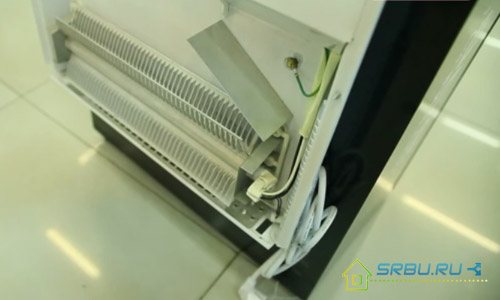

Disassembled electric convector and its heating element.
1. The heating element of the tape (otherwise, needle) type is a dielectric plate of small width, on both sides of which there are loops made of a chromium-nickel alloy. These hinges can be easily damaged as they are very fragile.
Therefore, now manufacturers have practically abandoned the manufacture of such heating elements. Moreover, they heat the air too slowly due to the lack of ribs. Here the body of the device itself is heated, and after it warm air moves.
2. A tubular heating element (otherwise, ten) has been deservedly recognized as the most popular for several decades. On the heater tube, along its entire length, there are aluminum fins. The more of them and the more often they are located, the higher the heat transfer.
+ Advantages of ten:
- The tube has a temperature much lower than the nichrome thread hidden inside it.
- Teng serves long enough - longer than a tape heater.
- Such a heater can work in rooms where the humidity is very high. In this case, the protection class IP24 applies.
- Cons of ten:
- When working, a small annoying crack is often heard. This is due to the difference in thermal expansion between the aluminum plates and the steel tube.
- There is a space between the aluminum fins and the steel tube, which increases over time. This results in heat loss.
3. There is one more type of heating elements - monolithic. They are constructed differently. All the same nichrome thread is placed in a die-cast aluminum case with ribbing, and a dielectric backfill is used to isolate them from each other. Here, if heat loss is observed, then it is minimal - after all, the difference in temperature expansion no longer exists. These heating elements are good for everyone: they are quiet, and the body of the device heats up a little, and practically does not lose heat.
Since the body of the device is hollow inside, it serves as a kind of wind tunnel, in which thrust is created by heating the air. While the convector is plugged into the network, the process of cold air passing through the heating element is continuously going on, it is heated and flowed upward. And so, portion by portion, the entire air of the room is gradually heated.
Convectors today are available in a wide variety of designs.
So, they are made:
- outdoor type;
- wall type;
- plinth type.
The first two models can be up to forty-five centimeters high. The latter are much lower - only up to twenty centimeters in height, but their length is impressive - sometimes up to two and a half meters.Such a model can be chosen for installation under a window opening, it makes sense to dwell on a similar model. Due to their long length, it is not very convenient to move them.
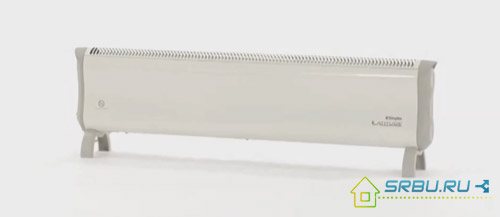

External view of the skirting-type convector.
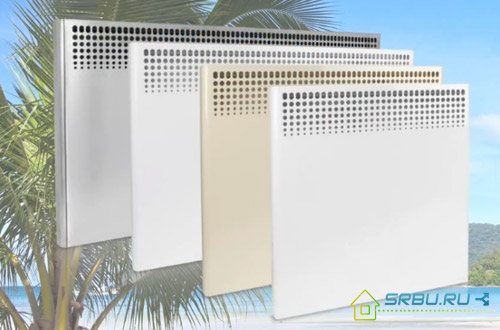

Wall mounted electric convectors.
Convectors are installed in two ways:
- on the floor
- on the wall.
They have wheels and a handle to move on the floor. But on the wall, the heaters are attached with special brackets. Thanks to this, wall models do not take up extra space in the room at all. Plus, they can blend in nicely with modern interior design.
Purpose and principle of operation of the electric convector
Before proceeding to consider the principle of operation of an electric convector, it is necessary to study its structure and design features. With this knowledge, it will not be difficult to understand the principle of operation of the device.
Design
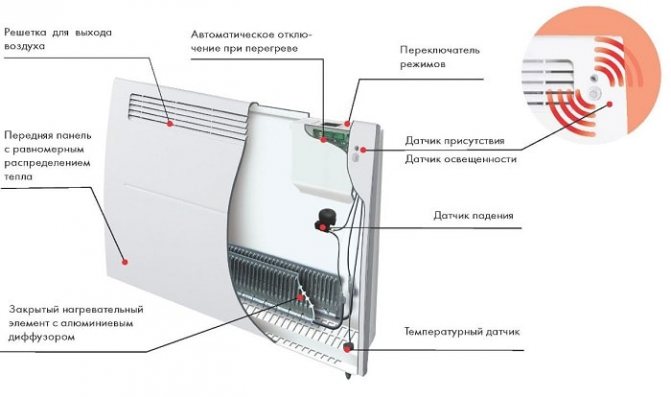

Regardless of the manufacturer and modification, any electric convector includes the following main elements:
- Housing.
Most manufacturers give preference to metal cases, which provide high strength in operation and the safety of internal modules in the event of overturning or other mechanical stress. To facilitate the structure, light alloys based on aluminum are used in the manufacture of the case. In the lower and upper parts, there are grilles for the intake of cold and return of warm air. - Electric heating element
... Thanks to these devices, the air circulating in the device is heated. In modern convector installations, several types of heating elements are used:
- Monolithic.
The cast body of such a heating element allows you to achieve high efficiency and quiet operation; - Tubular.
The design is a metal pipe with a nichrome thread stretched inside. The space between the thread and the inner surface of the pipe is filled with a heat-conducting bulk insulator. There are aluminum fins on the outer surface of the pipe to increase the heat transfer efficiency. - Needle-like.
Such a heating element consists of a dielectric base on which a chromium-nickel thread is fixed, covered with a special insulator. Installations with a needle heating element provide the fastest possible heating of the room, but they do not differ in durability.
Temperature sensors, location, and other protective elements that ensure the safe operation of the device;
Models with high heat output can be equipped with a fan to increase the air circulation.
Principle of operation
The operation of an electric convector is based on the natural circulation of air masses. Cold air coming from below heats up and rises up through the convector grill. As the temperature decreases, the cooled air gradually moves downward and the cycle repeats.
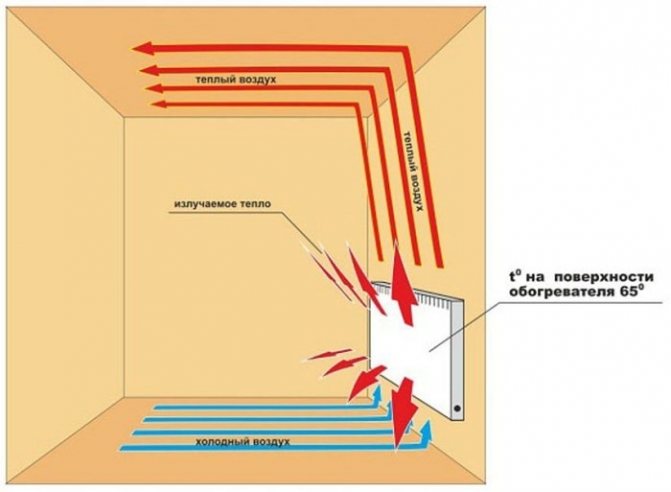

In addition, a certain amount of heat can be transferred due to thermal radiation from the front panel of the device, which is in close proximity to the heating element. It is the simplicity of the design that ensures the reliability and durability of the convectors.
Some models with a high heating element capacity can be equipped with a fan to increase the air circulation rate, thereby significantly reducing the initial heating time. The forced movement of air masses increases the efficiency of the device, but is accompanied by an increase in the noise level.
How to choose a convector?
Electric convectors are available in different capacities. How to choose the model of the required power? The convector is selected based on the characteristics of the room to be heated. In order to choose a convector, you will need the following information: the area of the room, the height of the ceilings, the number of windows.In our climatic zone, with a standard ceiling height (2.5-2.7 m), with a standard room thermal insulation for the main heating of 1 square meter in winter, 100-120 watts of electricity are required. Thus, for heating a room 15 sq.m. you need 1500 watts of power. Since convectors are recommended to be installed under windows, then with one window in this room a 1.5 kW convector will suit you, but if there are two windows in the room, it would be better to install a 750 W convector under each one (i.e. 2 pieces, in the sum is the same 1.5 kW). If you plan to heat the house only in the spring-summer-autumn period, the convector power can be reduced.
Keep in mind! In order to heat a room of a certain area, with specific thermal insulation properties, a completely certain amount of energy (in our case, electricity) is required. Those. when heating a room 10 sq.m. a 1000 W convector and a 1500 W convector will consume the same amount of electricity. It's just that a more powerful convector will warm up the room faster and turn off earlier, ceasing to waste electricity. However, if you take a low-power convector, a situation may arise that it will not be enough to warm up the room to the set temperature and it will work constantly. It is also necessary to remember about the maximum electrical power that is allocated to the house, as well as the power for which the wiring in the house is designed, in order to avoid exceeding it.
Wall convectors
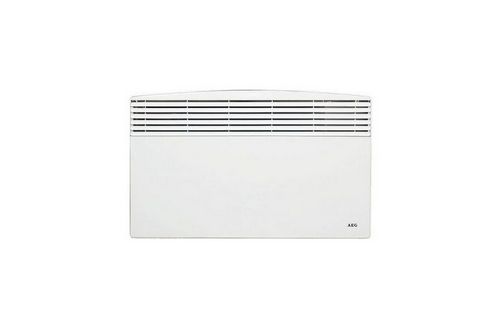

The wall-mounted convector is the most frequently chosen heating equipment by users. The heat regulator with the maximum room heating temperature saves energy, because when the set temperature is reached, the device turns off.
The wall-mounted steel convector with a thermostat maintains the optimum temperature even in a heated room. With intermittent heating in country houses, the convector will maintain a stable temperature, saving fuel for full heating of the building.
Convectors built into the window sill reliably protect the room from cold penetration. They don't take up much space.
Floor convectors
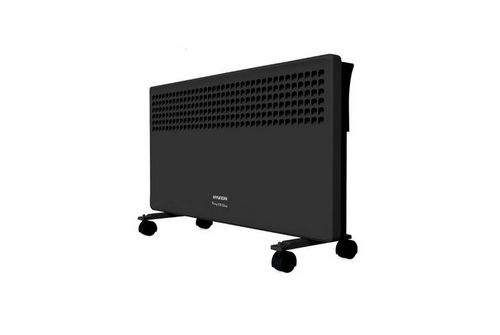

Installation of floor convectors does not require special skills, the instructions describe the entire installation sequence.
Floor convectors are divided into several types:
- with natural convection;
- with forced convection;
- able to function in rooms with high humidity.
Floor convectors are large bodies, of various lengths, depending on the convector's power. Easily fit into any interior, often made to order.
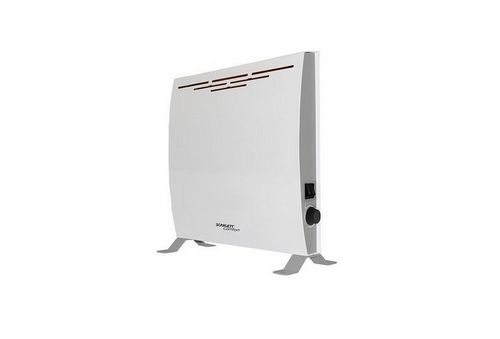

In the box itself there is a heat exchanger made of copper or aluminum with good thermal conductivity. Internal cleaning must be done every few years.
Floor convector
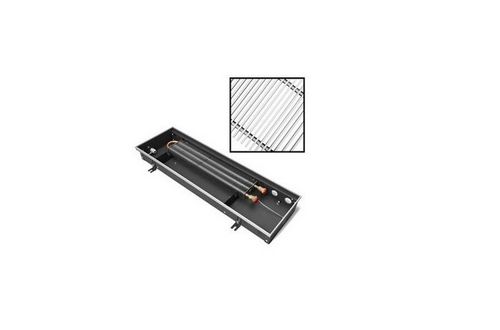

Floor convectors are radiators built into the floor. They are water and electric.
The skirting convector is used in rooms with an individual or central heating system.
Oil, water and other liquids are used as a heat source.
It successfully replaces the traditional heating radiator. It is a device consisting of a body made of various materials. As a rule, stainless or galvanized steel is used, which has increased resistance to corrosion.
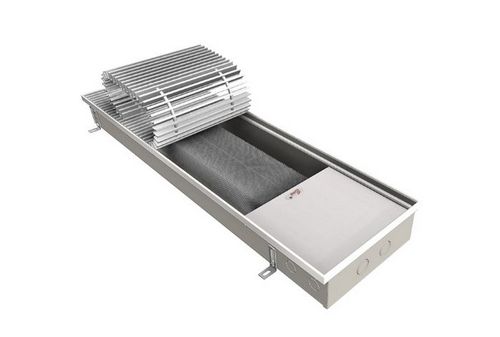

In the body there is a heat exchanger made of a copper tube bent in the shape of a horseshoe. The aluminum fins increase the surface area of the heat exchanger.
The decorative grille, mounted on top of the convector, is made of steel, wood, aluminum.
The capacity depends on the temperature of the supplied heating medium and the intensity of the air flow around the heat exchanger.
They are used in various heating systems operating in a wide range of coolant temperatures - from 45 to 90 ° C. The built-in tangential fan, which provides an increase in the air flow rate, increases the performance and the rate of heat transfer to the convector.
What additional options do convectors have?
Some add. the functions can really be useful. And if the device has them, then it is better to choose it than a more primitive device. For example, a temperature controller. This is very convenient if it is warm outside, screw it up a little, and if frost has come, set it to the maximum.
When buying an electric heater, it is necessary to carefully study all the subtleties of the placement of the device, its features, as well as other factors that affect the choice of a particular model.
Many models are equipped with a timer, this helps to turn on the heater at the right time, and then the device turns off by itself. It is convenient to do this before bed.
If an ionizer is built into the device, then it absorbs dust well, and the air is saturated with negative ions. It is good for health. It is believed that it is better to sleep in such a room and to work more comfortably. Well, if the heater is equipped with a remote control, it becomes more than convenient to operate it. And, of course, it is important that the heater has protection against overturning - this will protect children and animals from injury.
Types of electric convectors heating
When choosing climatic technology, it is important to take into account that electric convectors may differ from each other in the following characteristics:
- Mounting type.
- The heating element used.
You should also pay attention to the manufacturer of the product and the cost of electricity.
Types of electric convectors, according to installation features
Air convection heaters can be divided into three categories.
Wall mounted. Wall-mounted convectors are the most efficient. The location on the wall facilitates the convection process and increases the efficiency and heat transfer of the heaters.
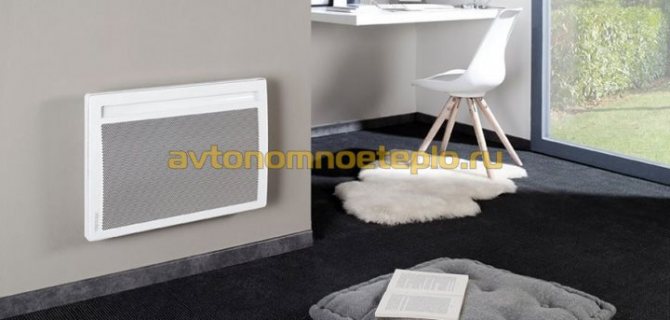

Floor-standing version - used as an additional source of heat. Models with a built-in fan differ in performance. The convector with forced air circulation cannot boast of quiet operation, but it warms up the air well.
Universal models - can be installed on the floor and mounted on the wall using special mounts. When choosing, you should pay attention to the presence of wheels in the kit. By installing the wheels on the body, you can easily move the heater anywhere in the room.
The main advantage of the convector is the low heating of the device body. This allows you to install a heater for heating a wooden house.
Classification of convectors according to the heating element used
In total, three types of heating elements are used. The design of the heating element affects the operation of the heater.
- Needle heating element - a simple design, is a chromium-nickel heating thread located in a dielectric plate. The top is covered with a special insulating varnish. The heater with a needle heating element is not suitable for wet rooms, since the heating element has absolutely no protection against the ingress of water, steam, condensation and other liquids. As a rule, budget models are equipped with a needle heating element.
- Tubular heating element - manufactured in a waterproof design. The structure consists of a steel tube filled with a heat-conducting backfill, which is also an insulator. To increase heat transfer, heat-distributing fins are fixed on the sides of the heating element, increasing convection. The heaters are equipped with overheating protection. As a disadvantage of the tubular heating element, one can single out the fact that the electric convector heats up for a long time. The operation of the appliance may be accompanied by sounds resembling the crackling of burning wood.
- Monolithic heating element - the most economical electric convectors for heating a private house use a monolithic type heating element. The body of the heating element has no seams, the work does not accompany extraneous noise. If it is planned to make the electric heating of the apartment with convectors the main one, then the models with a monolithic heating element are the best solution. During operation, minimal heat loss is observed. The heater efficiently and quickly heats the room. The only drawback of the monolithic heating element is the high cost of the device.
For space heating using an electric convector, it is better to choose devices that have a tubular or monolithic heating element and are equipped with a built-in electronic or programmable thermostat.
Where to install the convector?
It is recommended to install electric convectors permanently, under the window (like central heating batteries), thus creating a thermal curtain. It is desirable that the convector completely overlaps the window opening. The convector is hung on the wall at a height of 8-12 cm from the floor. The distance from the upper edge of the convector to the window sill should be 12-15 cm. In bathrooms, shower rooms, etc. the convector must be located so that the controls are inaccessible to the person taking a shower or bath. The socket into which the convector is connected must not be placed above the heating device.
If it is not possible to install the convector under the window, it can be hung anywhere else. Convectors designed for mobile installation are equipped with feet or castors and, without fail, a tipping sensor. Please note: some convector models may not be installed on legs or casters!
Which company convector is better to choose
Of course, when choosing a convector, the buyer seeks to choose a device in which price and quality are ideally matched. But it is difficult to compare the quality and cost of different manufacturers. For example, European-made convectors are of high quality, long service life and a long warranty term. But the price for them will also be high.
Chinese options are also presented on the market, the cost of which is much lower than that of European manufacturers. But the quality of such devices leaves much to be desired.
European convectors are usually represented by products from Italy, France and Germany. As for domestic heaters, modern models can quite successfully compete with European counterparts. And besides, they have one big advantage - manufacturers take into account the climatic conditions of our country, which are very different from Asia and Europe.
Compare models
Currently, there are three main types of devices from three manufacturers on the domestic market. These are the European brands "Noirot" and "Nobo", as well as the Chinese "Ballu". How do they differ from each other, except for the brand and manufacturer?
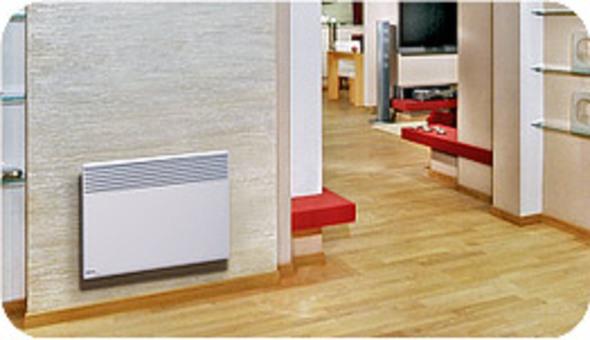

Noirot Spot E-II 1000W
- Europeans are inferior in their appearance, and their control is mechanical. However, Europeans have the highest warranty period. Chinese manufacturers offer remote controlled heating devices, which makes them more convenient.
- "Ballu" and "Noirot" include solid silumin heating elements (this is an aluminum alloy). Electric heating convectors nobo are equipped with sintered heating elements, which are inferior to the first in their characteristics.
- Ballu is considered a more advanced model. It uses a two-stage operation (half and full) to regulate temperature and save energy. In addition, this is the only device that is equipped with an eight-hour timer.
- The Ballu and Noirot brands have both floor-standing and wall-mounted versions. The Nobo version has the smallest thickness, which allows it to be used only as a wall version.But its length is longer than that of other analogues.
- "Ballu" is equipped with a rollover sensor, that is, when the device falls, the sensor cuts off the power supply.
Making a conclusion on the analysis of these three brands, it must be said that from the point of view of design and ease of management, it is best to give preference to the Chinese brand "Ballu". But if we consider devices from the standpoint of safety and reliability, then the palm should be given to the French device "Noirot". But for the price, all three heaters are almost the same, so you will have to make the main choice according to technical characteristics.
The best electric convectors 2018-2019 in the price ratio quality
Sometimes in a store it is difficult to decide which type of heating equipment is needed. Often, everyone prefers options whose quality matches the money spent. It is about such models that we will talk about in this section.
Convector ADAX VP 1020 KT - powerful and affordable
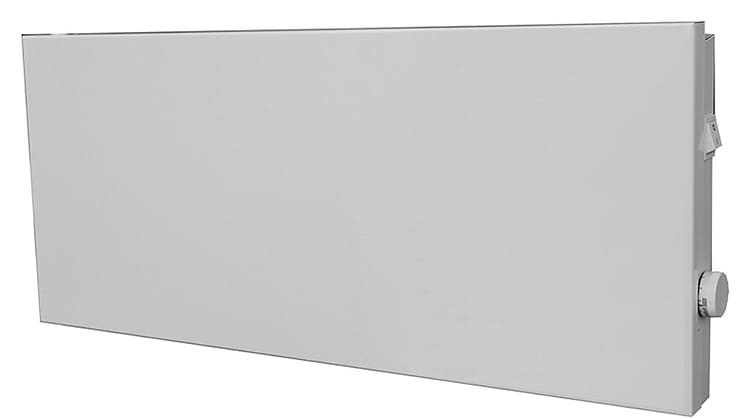

It is expensive to purchase electric convectors for a large multi-storey country house
Such a model is considered more functional, but, at the same time, it is distinguished by ease of management. Of course, this unit cannot be compared with premium analogues, but, nevertheless, it is not inferior to them in quality. This convector also has additional security. More details in the table.
| Power, W | Heating area, m2 | Control method | Mounting option | Additional options |
| 2000 | 15 | Mechanical | Wall | Temperature regulation, overtemperature shutdown, rollover protection |
ADAX VP 1020 KT
Convector Timberk TEC.PF10N DG 2000 IN
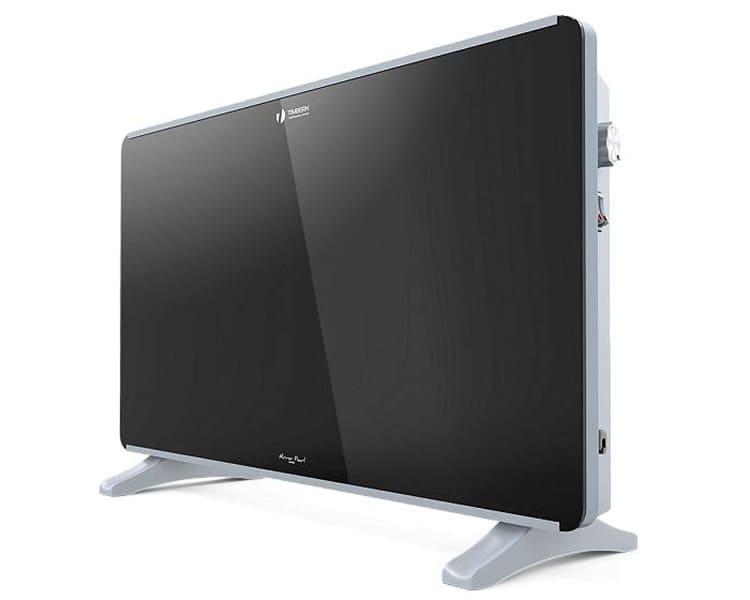

The metal body of the electric convector is heated up to 60 ° C
A model with an interesting facade. The back is made in the traditional way. The control panel contains control keys and a power regulator. This device is more convenient to use when installed on the floor. There are many interesting additions to this model.
| Power, W | Heating area, m2 | The presence of a thermostat | Control method | Additional options |
| 2000 | 23 | Yes | Mechanical | Temperature control, waterproof housing, front glass panel |
Timberk TEC PF10N
Convector Hyundai H-HV15-10-UI617 - model with simple parameters
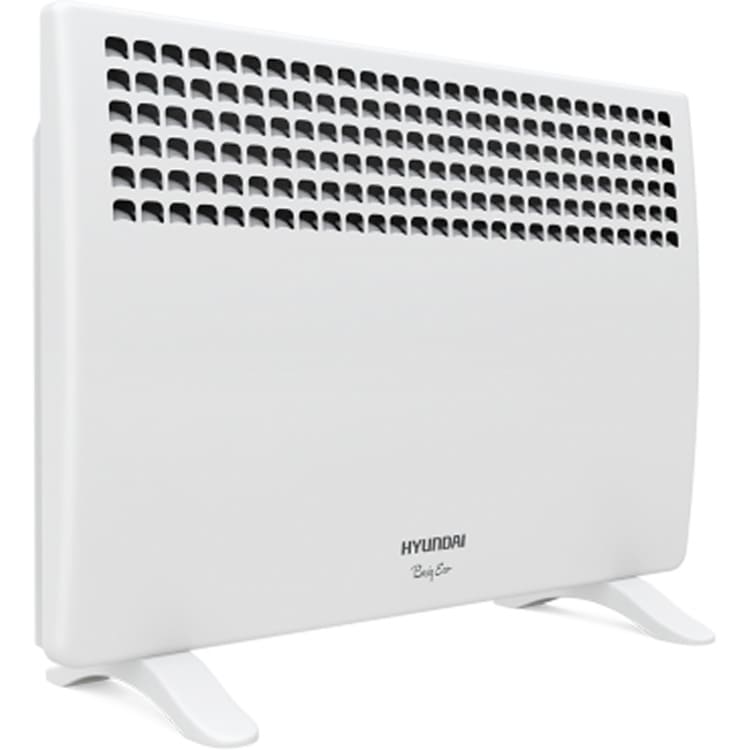

When using an electric convector, there is no need to install a fan in the room.
Simple in execution, easy to use and of high quality. All these characteristics can be safely assigned to the declared unit. The device is suitable for small rooms, but has excellent heat dissipation. Therefore, its use in everyday life is fully justified.
| Power, W | Heating area, m2 | The presence of a thermostat | Control method | Additional options |
| 1000 | 13 | Yes | Mechanical | Not |
Hyundai H HV15 10 UI617
GOOD TO KNOW!
Additional accessories can be connected to multifunctional models of electric convectors.
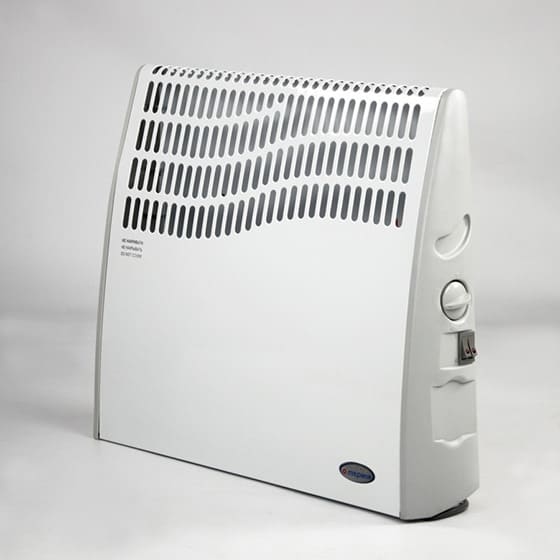

The best monolithic convector type heaters
Thanks to a well thought-out design, monolithic converters allow you to quickly heat a cold room. Air circulation is carried out through the gaps between the heating element and the metal case. The experts have selected several effective models.
Electrolux ECH / R-2500 T
Rating: 4.9
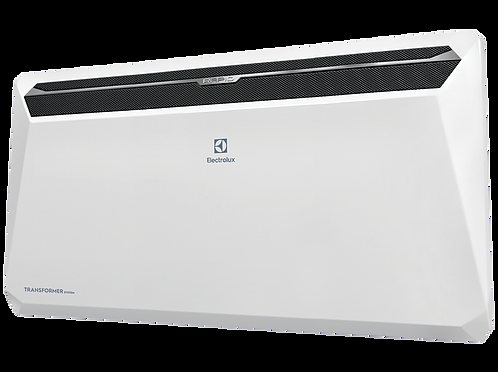

The maximum power is the Electrolux ECH / R-2500 T heater. Thanks to the Chinese assembly, the Swedish manufacturer managed to offer the Russians a democratic price. The device is designed to heat a room up to 30 sq. m. Due to the waterproof design of the case, the scope of the device is very wide. The design provides for the automatic shutdown of the heater in case of overheating, the electronics controls the degree of heating. The experts gave the model the first place in our review for the stylish appearance and high-quality assembly.
Users praise the high quality of materials, ease of use, built-in thermostat. The heater is robust, reliable and durable.
Advantages
- high-quality manufacturing;
- 5-year warranty;
- durable body;
- moisture-proof design.
disadvantages
- not detected.
Nobo NTE4S 12
Rating: 4.8
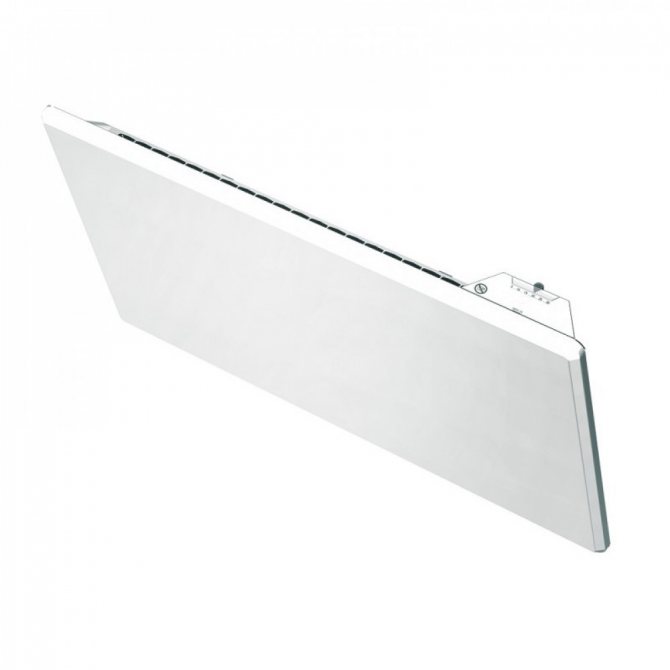

The Norwegian heater Nobo NTE4S 12 stands out for its high efficiency against the background of competitors. With an economical power consumption (1200 W), it is possible to create a cozy microclimate in a room with an area of up to 19 square meters. m. But not only in power the model is inferior to the leader of the review. The Norwegian device is more expensive and weighs more (5.7 kg). At the same time, the manufacturer did not install the wheels for moving. Experts appreciated the safe mounting of the device on the wall, the heater does not dry the air in the room.
Domestic users praise the device for its high build quality, economical power consumption, stylish design and slim body. Of the minuses, there is a high price and the absence of wheels in the kit.
Advantages
- heating efficiency;
- reliable fastening;
- economical energy consumption;
- high-quality assembly.
disadvantages
- heavy weight;
- high price.
Ballu BEC / EVU-2000
Rating: 4.7
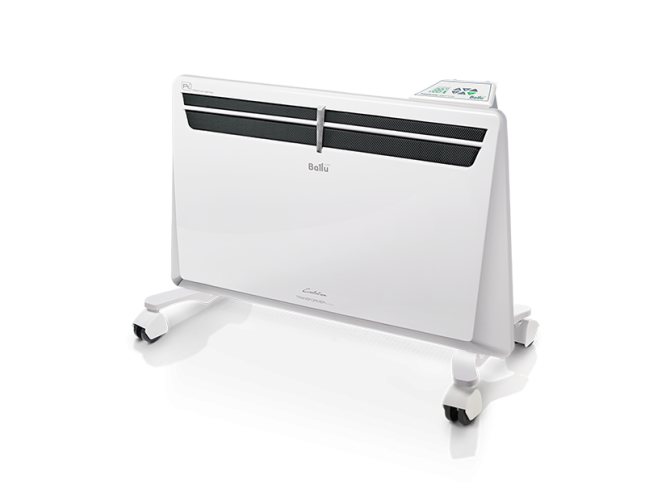

The convector BEC / EVU-2000 of the famous Dutch brand Ballu combines high power (2000 W) and easy control (electronic thermostat). The device is assembled in China, which makes it competitive in the Russian market. The device is capable of heating a room up to 25 sq. m. The manufacturer has provided for both floor and wall mounting, the kit includes all the necessary fasteners. The experts liked the modern LCD control panel. From the safety systems in the device there is a shutdown in case of overheating and overturning.
Users on thematic forums speak flatteringly about quiet operation, economy, versatility of installation. Of the shortcomings, the lack of a chassis in the kit and the soiled surface of the convector are often mentioned.
Advantages
- compactness;
- stylish design;
- versatility of installation;
- LED display.
disadvantages
- easily soiled surface of the case;
- no chassis included.
Timberk TEC.E0X M 1500
Rating: 4.6
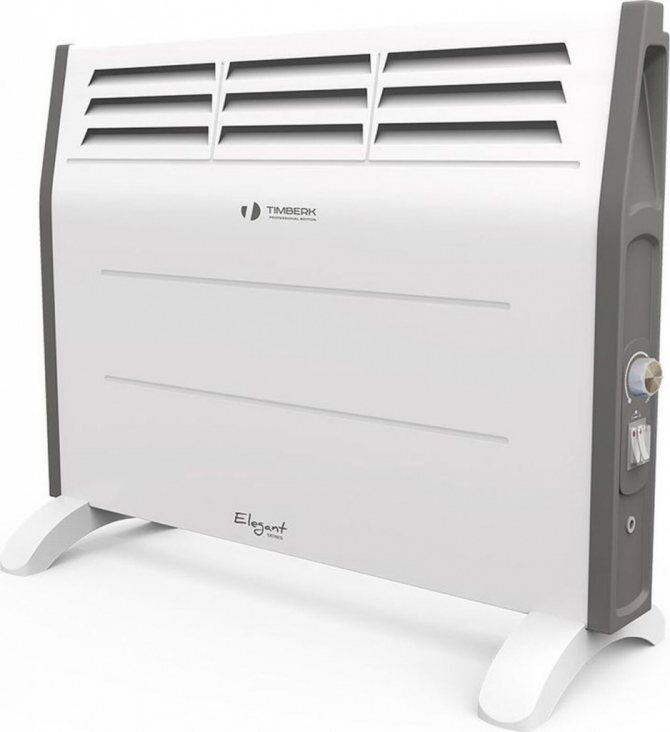

The laconic design, affordable price and safe construction helped the Timberk TEC.E0X M 1500 heater get into our review. Experts consider the device a worthy option for temporary or additional heating of a room up to 20 sq. m. The device is equipped with temperature control, thermostat, it can be installed on the floor or mounted on the wall. The manufacturer also took care of the safety of the electrical appliance; in case of overheating or overturning, the heating is automatically turned off. The model ranks fourth in our review.
The model review leaders could not be bypassed due to some critical user reviews. They are unhappy with the strong dehumidification of the indoor air. But the affordable price and fast heating can be added to the asset to the device.
Advantages
- laconic design;
- affordable price;
- operational safety;
- fast heating.
disadvantages
- strongly dries the air.
Hyundai H-HV16-15-UI621
Rating: 4.5
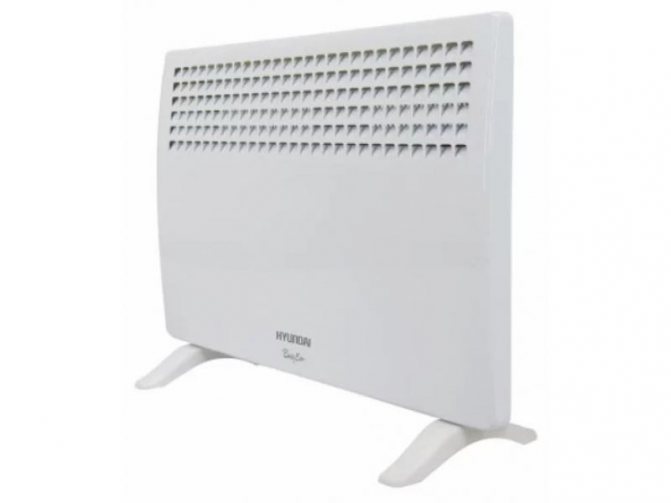

The Korean heater Hyundai H-HV16-15-UI621 brings a minimum of inconvenience to the residents of a house or apartment. It does not dry the air in the room, does not make noise, does not emit odors. At the same time, the model is sold at a low price. The experts praised the manufacturer for its high-quality assembly and stylish design. The appliance is equipped with a thermostat and can be wall-mounted or floor-mounted. The convector is not afraid of moisture, it can be used in the kitchen, bathroom or shower. With a power of 1500 W, the area of the room should not exceed 18 square meters. m.
Domestic consumers are satisfied with the lightness (3.8 kg) and compactness of the model, versatility of installation, and an affordable price. The appliance quickly increases the temperature in the room. Of the minuses, there is a strong heating of the case and uncontrolled operation of the thermostat.
Advantages
- high-quality assembly;
- fast heating;
- noiselessness;
- does not dry the air.
disadvantages
- the case is very hot;
- thermostat does not work.
RESANTA OK-2000
Rating: 4.4
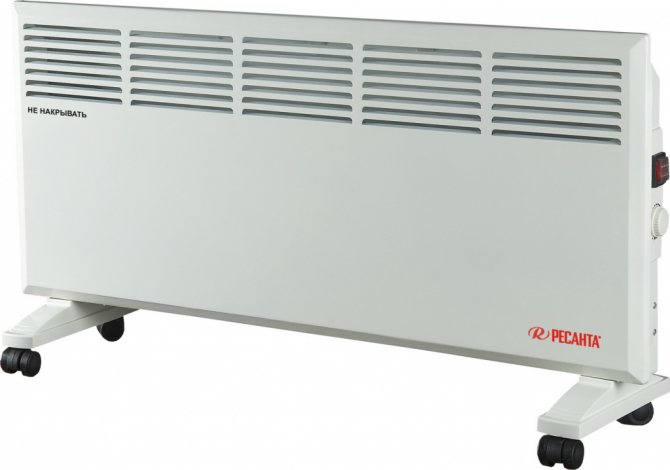

The heaviest model in our review was the RESANTA OK-2000 convector. Its weight is 6 kg. Perhaps that is why the Latvian-Chinese product is equipped with wheels for moving. The model looks decent in terms of power (2000 W), which allows it to be used in a room up to 20 sq. m. The device is well equipped functionally. There is a temperature control, thermostat, switch with light indication. In case of overheating, the heater switches off automatically. The convector body is reliably protected from moisture.
Users agree with positive reviews from experts when it comes to efficiency and functionality. The owners are unhappy with loud clicks when the heating is turned off and with a short power cord.
Advantages
- affordable price;
- high power;
- versatility of installation;
- ease of management.
disadvantages
- short cord;
- clicks loudly when the thermostat is triggered.
How does an electric convector work
In nature, there is a natural process of movement of warm and cold air masses. The heated air rises until it cools down, after which it goes down. The principle behind the movement of air currents is called convection.
In this regard, the question arises, an electric convector - what is it? This is a device using the principle of convection of air masses. The air heated with the heating element rises upward. After cooling down, it goes down and again falls into the heating block of the device.
To ensure continuous convection, air ducts are provided in the housing through which air is drawn in and out.
The principle of operation of the electric convector may differ slightly depending on the type of heating element used and the presence or absence of pressure equipment (fan).
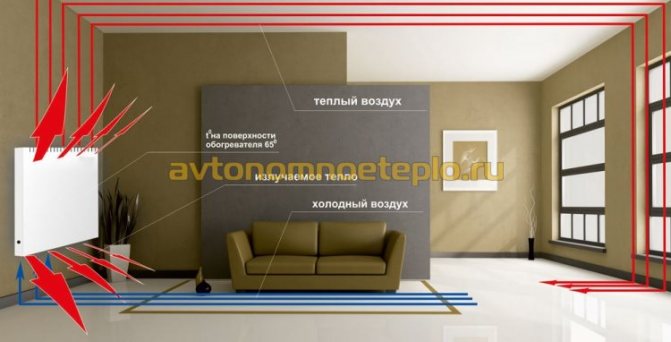

Heating element types
The electric convector (there are also gas and water convectors) is the most popular heating device on the market today. It has earned its reputation not only for its ease of use, but also for its reliability. This equipment is able to provide a comfortable environment both in the living room and in the public area. Experts believe that the main design feature is the absence of intermediaries for heat transfer.
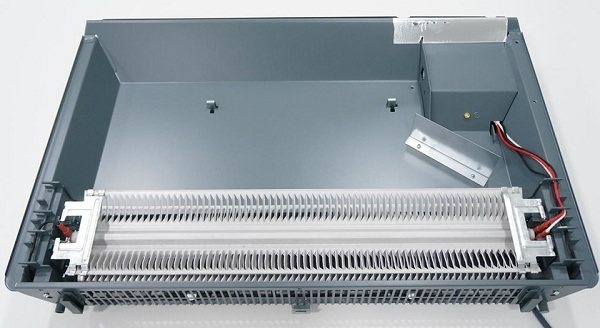

A modern convector uses one of three types of heating elements... He can be:
- needle, ribbon-shaped, stich-type heater;
- tubular electric heater with fins made of aluminum, abbreviated as it is called heating element;
- monolithic type.
Each type has its own characteristics and disadvantages. The decision about which one to choose should be made based on the characteristics of the heated room.
The best manufacturers of electric convectors
Currently, the most demanded electric convectors are:
- Ballu
... The company's products are presented on the market by both serial and exclusive designer units. The power of the devices can be from 0.5 to 2 kW. Ballu convectors are highly reliable and safe to use. The presence of a large number of additional functions and a reliable security system, in combination with an affordable price, have ensured wide popularity of the company's products. - Noirot
... Electric heaters from this company are characterized, above all, by high reliability. The average service life of the unit is at least 10 years. In addition, Noirot convectors are distinguished by reliable automation and great functionality. The various author's design of the units allows them to be used in any interior not only as a heating device, but also as a decorative element. - Electrolux
... All household appliances produced under this brand are distinguished by high performance characteristics, reliability and original design solutions. Electric convectors were no exception. Most of the models produced by the company have electronic control with a wide range of additional functions and reliable closed-type heating elements. Only the high cost of the equipment is somewhat confusing. - Timberk
... Convectors of this company are distinguished by exquisite design, variety of colors and shapes. As for the technical side of the issue, one can note the high build quality and reliability of the heating elements. The use of innovative materials and technologies allowed the company to achieve flawless operation of the units in high humidity conditions. Timberk convectors are affordable for most private home owners. - Neoclima
... The company is focused on the production of low-cost models of units. The power of the produced convectors makes it possible to efficiently heat a small house in the country. Despite the low cost, Neoclima units are distinguished by their reliability and long service life.
Currently, the choice of convectors makes it easy to select a model of the required power and appropriate design.
Smart solution: gas convector
Gas convectors operate on natural (main) or liquefied (balloon) gas. They do not need a power supply, except for those models that are equipped with a fan to improve air circulation.
But even without electricity, such devices work quietly - just the fan does not spin. The units are usually used as the main heating devices, but they can also play an auxiliary role.
Equipment advantages and disadvantages
Among the important advantages of gas convection heaters, in addition to "electrical independence", it is worth highlighting the following points:
- these devices are not afraid of frost, they can be safely left in unheated houses;
- the products are safe: the gas supply is automatically cut off in an emergency.
A significant advantage lies in the simplicity of the device, due to which the devices are quite reliable and please with high efficiency.
The equipment also has disadvantages:
- despite their small dimensions, gas convectors are usually difficult to successfully fit into the interior;
- you need to "hammer" the wall for the coaxial gas outlet.
A significant disadvantage is that the gas unit cannot be simply taken and "outweighed" the device to another place.
Gas convector design
The gas heater consists of the following units:
- Metal body. It is covered with heat-resistant paint. At the bottom and top, the structure is open for air circulation.
- Finned heat exchanger. Heats up the air. The larger it is, the faster the room temperature rises.
- Burner. Gas is burned here.
- Combined valve. Responsible for regulating the gas flow to the burner.
- Chimney. Conducts smoke away from the device. Not all manufacturers include a chimney in the delivery set - this is worth paying attention to when choosing equipment.
- Thermostat. Element for controlling the operation of the combination valve.
- Automation. Shut off the gas supply in emergency situations.
Also, the gas convector can be equipped with a fan, remote control (expensive models).
Recommendations for the selection of devices
The product must be adapted to the pressure in your gas system. The required power of the gas convector is calculated according to the well-known formula - for every 10 sq. m of the area of the premises requires 1 kW of heat. It will not be superfluous to add 1 kW to the resulting value for poor-quality insulation or old windows.
According to the method of fastening, the devices can be wall-mounted and floor-mounted.The first ones are lighter and more compact, have sufficient power; it is usually recommended to stop your choice on them.
A very important parameter when choosing a gas heater is the material from which its heat exchanger is made, this can be:
- cast iron;
- aluminum;
- steel.
The cast iron heat exchanger warms up evenly, has a fairly high efficiency, and is capable of operating for half a century. But since cast iron is a brittle material, under certain conditions (for example, a large temperature difference), it can burst. In addition, such a structure is heavy.
Aluminum heat exchangers have excellent thermal conductivity, but their heat resistance is low. The devices equipped with them are of high cost.
A steel heat exchanger is the best option. In terms of a number of characteristics, it is certainly inferior to its "competitors". But it's durable, lightweight, and cheap.
A good bonus in the design of a gas convector is the presence of a fan. It reduces the heating time of the room and reduces the risk of heat exchanger burnout, but increases the cost of equipment.


